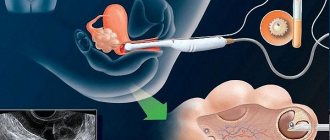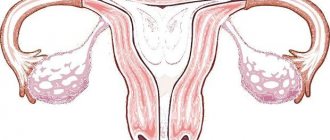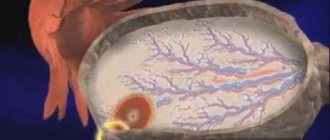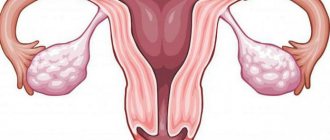The birth of a child requires enormous efforts from the female body, changes occur.
When the lower back hurts after embryo transfer, a woman should listen to her body. Successful fertilization, both in laboratory and in natural conditions, is often asymptomatic.
If your lower back hurts after embryo transfer, this may indicate a normal course of the process.
Sometimes this indicates problems with implantation, diseases of the female reproductive system, and problems with the spine.
Causes of pain in the lower back
A woman who has been waiting for a long time for the birth of a child undergoes multiple examinations.
With pathologies and diseases in the acute stage, she will not be allowed to undergo in vitro fertilization. This 99% eliminates the possibility of illness or inflammation at the time of transfer.
Often after IVF, the lower back is pulled due to stress and nervous tension after the procedure.
Doctors note other variants of pain syndrome:
- Individual characteristics of the body, low pain threshold. Implantation of biological material is carried out under local anesthesia.
Some time after the implantation, the effect of anesthesia stops, and sensitivity returns to the nerve endings in the uterus.
Lower back pain after embryo transfer due to irradiating signals. They occur in places not associated with the source of pain.
Progesterone production pattern
The back aches due to the implantation of embryos in the uterus.
- Also, after IVF, the lower back is pulled if there is an increased production of the hormone of the second phase of the cycle - progesterone. It is responsible for bearing a child and is produced by the adrenal glands, but mostly by the ovaries.
Progesterone relaxes smooth muscles, the entire load is transferred to the spinal column, which is accompanied by pain.
- If suddenly after IVF your lower back hurts, your doctor will tell you why. Sometimes this is associated with a complication in the form of ovarian hyperstimulation, they increase in size and cause pain in the suprapubic area and in the back.
The ovaries are stimulated with hormones before implantation; it is important to monitor the woman’s hormonal levels before implantation. Hyperstimulation can interfere with the implantation of embryos: follicles still continue to mature in the ovaries, which should no longer be the case.
Important! This symptom is often encountered by expectant mothers suffering from the formation of cysts or PCOS.
Doctors associate the main reasons why the lower back hurts after embryo transfer with the production of progesterone, implantation, or pain after the anesthesia wears off.
Sometimes the syndrome indicates problems with hormonal function, for which the ovaries are responsible. But there are other preconditions of an unpleasant nature.
Discomfort in the lumbar region has multiple causes. Sometimes it is caused by diseases of the reproductive organs, in particular erosion, inflammation of the endometrium, previous abortion with unsuccessful curettage, and genital infections.
Doctors highlight a wide list of possible causes:
- This also includes infections caused by violation of sanitary and hygienic standards during surgery in the pelvic area.
After embryo transfer, lower back pain occurs because previous diseases are not completely cured, and pregnancy is stressful or occurs against the background of previously undiagnosed pathologies.
- Spinal curvature, which is a chronic condition, lower back pain after embryo transfer due to the enlargement of the uterus, where several fertilized eggs can implant at once. The uterus grows, the load on the back in the lumbar region increases.
- Prolapse of the kidneys. Due to stress and nervous exhaustion, the kidney may drop, causing pain. For this reason, after embryo transfer, the lower back in women with insufficient body weight is pulled.
Colds with a temperature above 38 degrees and cystitis cannot be ruled out.
During seasonal diseases, preventive measures are taken.
But the possibility of psychosomatic disorders cannot be ruled out. A cold manifests itself against a background of nervous exhaustion and fatigue.
An hCG test can accurately inform you about the onset of pregnancy in the early stages. It is prescribed 2 weeks after IVF.
Before this, the expectant mother’s sensations and physiological signs can indicate that everything is going well.
- When, after embryo transfer, the lower back hurts, but the pain is tolerable and does not cause discomfort.
- There is an exacerbation of the sense of smell, taste preferences change, or toxicosis appears.
- The breasts swell, veins on the face or décolleté appear more clearly.
- Mood and sleep patterns change, resulting in insomnia or drowsiness. Possible irritability, tearfulness, apathy.
When, after the transfer of embryos, the lower back is pulled, but the condition is tolerable, the body temperature is not higher than 37.5 degrees, and minor nagging pain occurs in the lower abdomen, possible pink discharge, this is considered normal.
Body temperature 37.5 during IVF pregnancy
Important! A woman should focus on individual feelings. If severe pain, deterioration, or bleeding occurs, urgently contact the medical personnel who are responsible for IVF.
If bed rest and adherence to the treatment regimen prescribed by a specialist do not improve the condition, or the lower back hurts after embryo transfer for a long time or periodically, medical attention is needed.
Fainting during IVF pregnancy
Pay special attention to the following symptoms when it is important to call a doctor:
- The occurrence of fainting, weakness, severe pain. Sometimes this indicates internal bleeding.
- Hyperstimulation, which expectant mothers fear, will be indicated by a feeling of fullness in the pelvic area, shortness of breath, discomfort; sometimes, after embryo transfer, the lower back hurts for this reason.
Nausea and vomiting occur, and blood pressure may decrease. If taking antispasmodics does not bring relief, call a doctor immediately.
- If you experience chills, fever above 37.5 - 38 degrees, fever, foul-smelling vaginal discharge.
- A dangerous sign is bleeding, prolonged discharge mixed with blood, if after embryo transfer the lower back hurts frequently, periodically or severely.
Doctors advise once again to play it safe and contact the clinic at the slightest doubt whether everything is in order with the woman’s body.
Chills during IVF pregnancy
Statistics show that in 15% of difficult cases, medicine can save a long-awaited pregnancy.
In the case of natural fertilization, pain manifests itself in 10 cases out of 100, more often women after IVF have lower back pain, why, experts answer: this is a serious intervention in the body. For the first 5–7 days, you need to be patient and take care of yourself.
A woman should know: pain indicates that not everything can go smoothly, but you need to help yourself. They take medications prescribed by a doctor, often these are hormonal and painkillers. They adhere to a calm daily schedule, pay attention to proper sleep, physical and emotional peace.
They try to rest more, walk in comfortable shoes, without high heels, which create additional stress on the lower back. And they remember emotional comfort. Stress and nervousness increase the risk of uterine tone, which manifests itself in spinal pain.
Lower back pain after embryo transfer, including after cryoprotocol (cryotransfer), can be a completely normal phenomenon, but more often it is a symptom of a pathological process: inflammation, implantation disorders, problems with the spine, etc. The source of the symptom can only be determined after a comprehensive diagnosis.
Risks at the preparation stage
Immediately before transferring the resulting embryo into the uterine cavity, women undergo preparation for this moment. Eco is a multi-stage and complex process, which may be accompanied by some complications due to the drugs and manipulations used.
Side effects of hormone therapy
In order for a woman to enter into the in vitro fertilization protocol, she will undergo quite extensive hormonal therapy. Since patients often come to fertility clinics with hormonal imbalances, IVF requires subtle correction of hormonal levels. This, in turn, requires the prescription of certain doses of steroid drugs.
Hormonal drugs, due to their effect on the liver, cardiovascular, and nervous systems, can cause the following symptoms:
- Noise in ears;
- Dizziness;
- Nausea, vomiting;
- Decreased appetite
- Fatigue, lethargy;
- Menstrual-like discharge.
Ovarian stimulation
Stimulation of ovulation is one of the most important and main stages of the in vitro fertilization protocol. The purpose of such manipulations is to provoke the maturation in the ovaries of as many follicles as possible, which contain mature eggs. In one procedure for stimulating ovulation, it is possible to achieve the maturation of 15-20 follicles, when during the natural course of the ovarian-menstrual cycle the maturation of 1-2 follicles occurs. Next, they are punctured and mature eggs are collected for the purpose of their subsequent fertilization in an embryological laboratory.
The most dangerous complication of hormone stimulation is ovarian hyperstimulation syndrome. This is a condition that consists of an excessive response of the ovaries to the use of steroid drugs.
The pathogenesis of this syndrome is complex and depends on the administration of large doses of hCG. It is known that human chorionic gonadotropin stimulates the release of mediators that have a powerful effect on the vascular system, resulting in an increase in the permeability of the vascular wall. For this reason, massive penetration and sweating of fluid into the intercellular space occurs due to this phenomenon and the characteristic clinical symptoms of this pathological condition appear.
OHSS can be mild, moderate or severe.
1. Clinical manifestations of a mild form of ovarian hyperstimulation syndrome are characterized by a feeling of bloating and heaviness in the lower abdomen.
2. For moderate severity of manifestation of this condition, the following symptoms are characteristic:
- Bloating and heaviness in the lower abdomen;
- Feeling of nausea and even vomiting;
- Diarrhea.
3. The severe form is characterized by the following clinical picture:
- Pain in the lower abdomen becomes intense and sometimes unbearable;
- There is severe dizziness;
- Frequent vomiting;
- Uncontrolled weight gain in a short period of time;
- Decreased amount of urine produced by the kidneys (oliguria);
- Shortness of breath, difficulty breathing;
- Thrombosis may occur after IVF;
- Severe swelling.
With mild to moderate degrees of hyperstimulation syndrome, the woman is under dynamic outpatient supervision of an obstetrician-gynecologist. If severe symptoms appear, then doctors must hospitalize the woman to monitor her condition and carry out treatment measures. As a rule, with progressive pregnancy, this clinical picture disappears by the 8th week of pregnancy. However, if pregnancy never occurs, then the clinical manifestations of this condition quickly disappear.
The consequences of ovarian stimulation can be ascites (accumulation of fluid in the abdominal cavity), pleurisy (effusion in the pleural cavities), and an urgent situation such as ovarian torsion may occur; quite rarely, bleeding from an ovarian cyst can occur.
Bleeding from a cyst
Due to hyperstimulation of the ovaries, fairly large cysts can form on their surface. These are follicles that are overstretched with excess follicular fluid. If there is an excess of it, a situation may arise in which the walls of the cyst rupture and its contents are released. Unfortunately, in some cases, a vessel may be injured, from which bleeding may begin. With timely identification of the process, in some cases conservative treatment is possible, and if such therapy is not possible, surgical treatment is used. Its volume is determined by the clinical situation, as well as the amount of blood loss.
Causes of pain after IVF
In most cases, embryo implantation occurs completely painlessly, including no discomfort after the procedure itself. If after IVF the lower back is pulled, it signals that the manipulation was carried out contrary to contraindications, since artificial insemination is not allowed for diseases occurring in the acute stage.
If after cryotransfer or regular IVF your lower back hurts or your lower abdomen feels tight, the reason may lie in your emotional state - nervous tension and stress caused by fear of failure. Other sources of discomfort in women after embryo transfer:
- Low pain threshold. Manipulations, including puncture when taking follicles, are carried out under local anesthesia, so slight discomfort may occur after its effect wears off.
- Implantation of the embryo into the uterus. By increasing the production of the hormone progesterone, which is responsible for bearing a child, smooth muscles relax and loads are transferred to the spine, which is accompanied by pain symptoms.
- Ovarian hyperstimulation, as a complication of IVF, which is characterized by an increase in the size of the paired organ and pain in the back, above the pubis.
In most cases, lower back pain during embryo implantation occurs due to increased production of progesterone and the cessation of the effect of the anesthetic drug.
Pain in the lower back or lower abdomen the day after embryo transfer (ET) and in the future may occur due to hormonal imbalance associated with various diseases: pathologies of the uterus or appendages, for example, erosive neoplasms, inflammation in the endometrium, abortion with complications in history, sexually transmitted infections.
Discomfort after embryo implantation occurs when sanitary and hygienic standards are violated during IVF. Other reasons include untreated diseases at the time of transplantation, to which the body reacts after pregnancy with pain of various localizations: in the lower back, lower abdomen, etc.
If the attachment was successful, but pain in the lower back is still present, the reason may lie in the presence of problems with the spinal column. For example, with a diagnosed chronic curvature of the spine, discomfort in the lower back is due to an increase in the size of the uterus and the load on this section.
Stress and nervous exhaustion contribute to the development of pathologies such as kidney prolapse, which is accompanied by pain. Insufficient body weight is also a predisposing factor. Colds cannot be ruled out as the cause of lower back pain, which occurs with an increase in temperature.
IVF results: what affects?
The likelihood of pregnancy after IVF is influenced by many factors. For example:
- Age of future parents. Everyone knows that the most favorable reproductive age for a woman is from 20 to 30 years. After 35 years, the likelihood of getting pregnant, successfully carrying a pregnancy and giving birth to a healthy child becomes lower. By this age, the number of eggs in a woman’s body decreases, and their quality deteriorates.
- Duration and cause of infertility. How much time a couple has spent dealing with infertility also plays an important role. The longer a woman cannot get pregnant, the more the chances of a successful IVF outcome decrease. However, it should be remembered that the causes of infertility are different for each couple, and accordingly, the fight against them will be individual.
- Anti-Mullerian hormone indicator. This hormone is produced in the ovaries, if its level is less than 0.8, then there is a risk of a negative outcome of artificial insemination. However, AMH levels can be changed with the help of properly selected drug treatment.
- Quality of biological material. The positive outcome of the IVF procedure depends on whose material was used during fertilization. Statistics show that couples who used donor eggs and sperm are more likely to conceive and give birth to a healthy child than couples who used their own biological material. This is explained by the fact that donor material is carefully selected and examined to exclude the birth of children with pathologies.
- Women who have given birth. Those women who have already become mothers, regardless of the method (natural pregnancy or artificial insemination), are more likely to achieve the desired outcome. These women often leave good reviews on day 12 after embryo transfer, and a positive test is proof of this.
- BMI. Some experts believe that the fertilization process is also affected by a woman’s weight. A body mass index of 19 to 30 is considered optimal. In this case, the chances of getting pregnant and giving birth are much higher.
- Bad habits. Alcohol affects the effectiveness of medications taken, and tobacco interferes with successful embryo implantation. It is also better to give up coffee.
- Positive attitude. Despite the fact that the emotional state does not have a direct impact on the outcome of the procedure, an optimistic attitude is always necessary.
What symptoms may be present after IVF?
It is impossible to say for sure that pregnancy occurred before the 14th day after the replantation. The effectiveness of IVF can be confirmed after a hCG test, which is prescribed 2 weeks after DPP.
The following symptoms indicate a successful course of the embryo attachment process:
- discomfort in the lumbar region, which does not affect the general condition and does not reduce the ability to work;
- increased sense of smell, changes in taste preferences, symptoms of toxicosis;
- swelling of the mammary glands;
- distinct manifestation of veins in the face and chest;
- changes in mood, disruption of work and rest schedules.
Approximate symptoms during the first two weeks after embryo transfer:
- From 1 to 5 days after DPP. During such a period, symptoms arise due to emotional experience and excitement, fears of failure: violation of work and rest schedules, mood changes, malaise, headache. During the first five days, active division of the embryo occurs, liberation from the protein shell, penetration into the uterine endothelium and consolidation.
- From 5 to 8 days after DPP. A nagging pain occurs in the lower abdomen, and bleeding may occur. Symptoms indicate implantation of the embryo into the endometrium. Some women experience a slight increase in temperature (general and basal). Appetite decreases, emotional instability is observed. Numerous reviews confirm that you want to go to the toilet more often to empty your bladder. On the 7th day, the placenta begins to form and the hCG level increases.
- From 9 to 14 days after DPP. If the lower back or lower abdomen hurts 8-11 and up to 14 days after embryo transfer, the breasts swell and become sensitive, these are normal symptoms indicating successful IVF. Based on the results of the hCG test, if the lower back is pulled at 9 DPP, you can determine the presence of pregnancy with 100% probability.
Normal symptoms of early pregnancy are nagging pain in the lower back and lower abdomen, absence of fever, beige or pinkish discharge that does not resemble menstruation.
If even following bed rest and following medical recommendations do not help improve the condition, the pain syndrome persists and does not ease, you need to visit a specialist.
The following clinical manifestations should alert you:
- pre-fainting and fainting state;
- severe weakness, chills;
- severe pain that impairs ability to work;
- signs of internal bleeding, discharge of foul-smelling bloody exudate from the vagina;
- feeling of lack of air;
- nausea and vomiting syndrome;
- decreased blood pressure, increased temperature to 37 degrees or higher.
Based on the statistics, we can conclude that in 15% of cases of timely consultation with a doctor, pregnancy can be saved.
How you feel by day of pregnancy
The presence of certain clinical symptoms of pregnancy is determined by day. Each period is characterized by its own manifestations.
At the 3rd stage of embryo development, the process of penetration of the blastocyst into the uterine mucosa begins. Clinical signs during this period are not specific. A woman may experience headache, weakness, and fatigue.
The embryo completes its immersion into the endometrium. Characteristic symptoms for 4 DPP are drowsiness, emotional lability, and headache.
The fetus begins to receive nutrients from the mother's bloodstream. Clinical symptoms include discomfort in the lower abdomen and possible bloody discharge from the genitals.
Thanks to the enzymes produced, the embryo penetrates deep into the uterus. This is accompanied by an increase in basal temperature and periodic aching pain in the lower abdomen.
A week after embryo transfer, the formation of the placenta begins. Characteristic symptoms for this period are discomfort in the lower abdomen, weakness, and increased basal temperature.
HCG begins to be produced. The symptom complex does not differ from previous days.
The fruit begins to actively develop. In parallel with this, the concentration of hCG increases. Clinically, this is expressed in an increase in the size of the mammary glands and the appearance of heaviness in the abdominal area.
The concentration of hCG continues to increase. The formation of the nervous and skeletal systems of the fetus occurs. A woman may feel discomfort in the mammary glands. This is due to hormonal changes in the body.
As the embryo grows, new clinical signs appear. These include bloating, dyspeptic disorders, and changes in eating habits.
HCG levels reach high levels. The symptom complex does not differ from the previous day.
The 13th day after embryo transfer is characterized by a feeling of heaviness in the abdomen, an increase in size and increased sensitivity of the mammary glands, weakness, and emotional lability.
The embryo continues to grow. On the 14th day of pregnancy, a blood test for hCG is allowed. This period is characterized by drowsiness, mood swings, and discomfort in the lower abdomen.
The hCG level reaches high levels, indicating the successful completion of the embryo transfer. As pregnancy progresses, new symptoms appear. Their severity depends on the individual characteristics of the woman’s body.
All sensations that appear up to 2 weeks after embryo transfer are subjective. The exception is acute conditions. Reliable signs of pregnancy appear after 14-21 days of gestation.
Many people know that for women who are unable to get pregnant on their own for various reasons, there is a procedure for artificial insemination. But not everyone knows what a woman experiences during the procedure itself or, for example, what she feels on the 12th day after embryo transfer. Let's try to figure it out together.
Tips for relieving discomfort
If lower back pain is caused by physiological reasons and is not associated with IVF complications or diseases, you can take measures to relieve the symptom:
- Compliance with moderate physical activity. There is no need to overload the body with high physical activity. It is recommended to avoid exercises that involve a vertical load on the spinal region.
- Visit to the swimming pool. When immersed in water, your own weight decreases, in addition, all the muscles of the body begin to work one by one, helping to prevent overload of any part. The complex improves the functioning of the heart, blood vessels, and respiratory organs, and increases adaptive and protective functions.
- Yoga mom. This technique involves excluding twisting, bending, and postures with inversion of the body from the set of exercises. Exercises from the complex help relax the body, relieve tension from the limbs and spine, and restore normal breathing.
If your professional activity requires sitting for most of the day, it is recommended to purchase a comfortable chair for work, take 5-minute breaks every hour, during which you do light back exercises. It is not recommended to slouch while sitting; you should keep your back straight. Otherwise, the risk of poor posture and the development of lordosis, kyphosis, and scoliosis increases.
You need to spend at least 8 hours sleeping. It is recommended to sleep on your side. You can purchase a special pillow for pregnant women, which will also be useful in later stages. The device reliably fixes the pelvis and shoulders in a natural anatomical position, eliminating improper load on the spine.
If you are stretching the side of your lower back after in vitro fertilization, you should not look for the cause on your own at home. Only a doctor can find out why discomfort occurs and determine tactics for treating pain.
In an effort to find long-awaited sensations after embryo transfer, expectant mothers listen to their bodies, hoping to feel the slightest symptoms of a completed pregnancy. They try to feel the successful implantation of the embryo after the IVF procedure by any changes in well-being. Women are especially sensitive to their condition, for whom in vitro fertilization is the last hope of having a baby.
Specialists performing embryo transfer are confident that women’s new sensations are caused by the action of hormonal support agents that promote better survival of the embryo and some pain after the puncture. Whether there are any manifestations of implantation itself after embryo transfer or whether there are no sensations is a controversial issue.
How to survive the wait?
From the moment the embryos are transferred until you find out whether pregnancy has occurred or not, at least 2 weeks will pass. How not to go crazy from worries and worries? Initially, it is precisely experiences and worries that need to be excluded from your life. And then follow the doctor’s recommendations, which he, based on your individual characteristics, will give you.
Many, experiencing sensations like before menstruation, on the 12th day after embryo transfer, begin to observe bed rest and move less, so as not to inadvertently disrupt the long-awaited pregnancy. Others, on the contrary, try to occupy themselves with all sorts of things so that the wait is not so painful. Which course of action to choose depends only on how you feel and your doctor’s recommendations.
Causes of abdominal pain
The IVF procedure involves the process of embryo implantation (transfer and subsequent attachment of the embryo to the wall of the uterus). Before implantation, the egg undergoes cultivation and fertilization. The very introduction of a fertilized embryo into the wall of the uterus is, although simple, still a surgical intervention.
It is possible for a woman to have abdominal pain for some time after IVF - this is normal.
The nature of the pain can be nagging or aching, but experts are quick to reassure that after IVF this phenomenon is considered normal. That is, the implantation of the embryo into the wall of the uterus occurs with subsequent pain.
Control and support
After the transfer, and often before, the woman is prescribed hormonal medications. They contribute to the development of the corpus luteum, endometrial growth and excellent embryo attachment. You cannot take hormonal medications on your own; they can only be prescribed by your attending physician, who is fully aware of your health condition.
Some women note that on the 12th day after embryo transfer, they feel as if a foreign body is in the uterine cavity. There is no need to panic; most likely, this is a far-fetched subjective feeling. In addition, during natural pregnancy such sensations are also not uncommon.
How to know about a successful pregnancy
Often women wait for some unprecedented sensation to appear after embryo transfer with successful implantation. But most often, in a healthy body, this procedure is almost asymptomatic and it is not possible to detect any bright manifestations of pregnancy. Primary symptoms usually appear 11–14 days after implantation and behave like a normal pregnancy. It is recommended to monitor basal temperature, which is usually increased after embryo transfer. If for several days your basal temperature does not increase and remains below 370, then most likely you will be disappointed.
Danger Signals
There is an erroneous assumption that the same protocol and the same state of health in different women leads to the same result. It is worth understanding that each woman’s body is individual, as is her hormonal background. You can compare your feelings with what others experience, adjusted for the specifics of your history of the IVF protocol. Many people experience pain in the abdomen and lower back after embryo transfer. However, the reasons for this phenomenon may be different. In vitro fertilization is a surgical procedure involving intervention into the body of the uterus. It is rarely asymptomatic. After it, many women experience nagging pain for some time, as when menstruation begins. If you refrain from physical activity on this day and exclude other negative factors (for example, taking a hot bath), the unpleasant sensations will subside.
Complications and abdominal pain after IVF
Let's consider a number of the main reasons that provoke abdominal pain, like before menstruation:
- A woman who has undergone an IVF procedure may experience pain in the lower abdomen due to mechanical trauma. Artificial insemination involves puncture of the follicles, which is carried out using a puncture needle under ultrasound guidance. This is necessary to obtain a mature egg. Although the intervention is microscopic, microtrauma is still present, and this may be the most direct consequence of pain in the ovaries.
- Constipation and increased gas production. The reason in this case should be clarified and determined by a general practitioner.
- Ovarian hyperstimulation syndrome can be directly related to a high dose of hormones introduced into the body, as a result, the lower abdomen hurts and feels like before menstruation.
- Due to changes in the hormonal background, a woman may experience abdominal pain and cramping, like before her period.
- The increase in size of the uterus is a consequence of the fact that several embryos are maturing in its cavity at once, and this can be manifested by abdominal pain, similar in nature to pain before menstruation.
When carrying out embryo transfer, the overwhelming percentage of patients (80%) experience pain.
But don’t be too scared, because after the transfer, nagging pain in a woman’s stomach, like before menstruation, is far from uncommon. In addition, successful attachment and development of the fetus is always accompanied by nagging pain and discomfort in the abdomen. Abdominal pain after a transplant can be a confirmation that everything is going well.
What is embryo transfer
The very definition of the word “transfer” in this case means that an embryo fertilized outside the woman’s body is placed into the uterine cavity with the help of special instruments. This method of conception is used by couples who have difficulty achieving pregnancy naturally, or who have diseases or pathologies that are the basis for IVF.
Embryos that have passed a certain developmental path are subject to transfer. As a rule, on the third to fifth day of cell maturation, it can be used as a biomaterial for replanting. Once in the natural environment, the embryos must implant in the body of the uterus. However, this does not always happen and not immediately. In 40-50% of cases, the attempt is unsuccessful, the cells (blastocysts) die, unable to attach. Some women may feel a tug in their stomach after embryo transfer. This does not mean that there is no chance. Pain symptoms can appear for various reasons. Let's consider what symptoms the doctor should immediately respond to and begin to take action.
Follicle puncture
In the second stage of IVF, several punctures are made to the ovaries to extract eggs from the follicles. This procedure is painless for women because it is performed under general anesthesia.
But during the manipulation, blood vessels are damaged, and hematomas may form. Painful sensations occur due to compression of nearby tissues by blood clots. Ovarian damage and bleeding sometimes occur.
How long the stomach hurts after follicle puncture depends on the severity of the complication. If everything went well, the pain is felt for no more than 2 days. If hematomas occur, it can last a week. If cysts have formed, long-term treatment is required - several months. Sometimes it ends with surgery.
If spasms, stabbing and cutting severe pain occurs that cannot be tolerated, you need to seek help from a doctor. The intensity of the pain syndrome depends on the woman’s pain sensitivity threshold and the strength of her immunity.
Stomach pain after IVF puncture if ovarian hyperstimulation (OHSS) develops. The following symptoms occur:
- nausea, vomiting;
- ascites in the abdominal cavity;
- dyspnea;
- painful urination;
- intestinal dysfunction leading to bloating and diarrhea;
- feeling that everything inside hurts.
Scanty bleeding may also appear and the temperature may rise to 38 °C.
The IVF protocol ends with the implantation of embryos into the uterus. The previously selected oocytes were placed in a test tube along with spermatozoa, where embryos were grown from them over the course of 3–5 days.
Now it's time to place them in the reproductive organ. This procedure is painless, but very responsible. The woman is overcome with great excitement and fear.
It is important that the patient is in a calm, relaxed state. If you cannot cope with anxiety, it is recommended to take a sedative pill.
Women usually worry: should their stomach hurt after embryo transfer? Of course, there will be unpleasant and painful sensations. The body reacts to the appearance of embryos in the uterus.
Discomfort and other symptoms appear:
- slight bloating;
- dizziness;
- engorgement and sensitivity of the mammary glands;
- weakness, fatigue;
- sleep disturbance;
- pink spotting (slight bleeding);
- increased rectal temperature;
- emotional instability.
Should my stomach be pulled after embryo transfer? What influences the occurrence of pain? Nagging pain is inevitable, it is felt by 80% of women who have used artificial insemination.
After IVF, the stomach feels tight, because the embryos must adapt to the new environment, and the woman’s body must adapt to new conditions.
Pain syndrome is supported by the following factors:
- Taking hormonal medications. Disruption of the normal process of hormone production causes pain even without pregnancy.
- Increase in the size of the uterus. The maturation of more than 1 embryo in the uterus leads to its enlargement. This causes pain in the ligaments that support the organ.
- Ovarian damage remaining after puncture.
- Ovarian hyperstimulation.
- Intestinal dysfunction.
If during IVF the lower abdomen feels tight after the transfer, there is no need to panic when the nagging pain, localized just above the pubis, is combined with scant pinkish discharge and elevated temperature in the first week after implantation.
Women should be prepared for stomach pain after embryo transfer.
IVF only gives a positive result on the first try in half of the cases.
Therefore, there may be complicated symptoms:
- dyspnea;
- severe nausea and vomiting;
- headaches, dizziness;
- the appearance of spots before the eyes;
- urinary disturbance;
- swelling;
- increased bleeding;
- increasing chest pain;
- painful bloating;
- diarrhea.
If such symptoms appear, you should immediately consult a doctor.
Whether the lower abdomen feels tight after embryo transfer or not, a woman does not need to change her usual lifestyle. It is only supplemented by the following rules:
- Minimum physical activity and maximum rest, avoid sudden movements.
- Get eight hours of sleep every day (lying on your back or side).
- Take quiet walks in parks and forested areas, avoiding fatigue. Evening exercise is especially useful.
- Eliminate stress, worries and worries. To stay calm, a woman is recommended to take soothing decoctions of valerian, motherwort, mint, lemon balm, chamomile, and linden flowers. Other drugs can be used only on the recommendation of a doctor.
- Provide a balanced diet. It should include lean meat, dairy products, fish, herbs, nuts, vegetables and fruits in sufficient quantities.
- Drink plenty of fluids – 2.5–3 liters of clean water.
- Avoid visiting crowded places where you can catch the virus or get a stroke.
- Avoid visiting bathhouses and saunas.
- Monitor stool, urine and weight.
Even air travel and long trips by transport are allowed. As for sexual activity after IVF, it is contraindicated for 2 weeks after implantation, because it provokes tension in the uterus. If a woman’s health does not allow it, sexual activity is excluded for the entire pregnancy.
So, peace, walks, fresh air, proper nutrition will help cope with unpleasant sensations. To reduce pain, you can take a no-shpa tablet. The main thing is that there is no increase in these symptoms.
A person's temperature drops when he sleeps and immediately after waking up. It is called basal (BT), or rectal, based on the way it is measured.
Measurements can be taken orally or in the vagina, but these readings are non-standard and subject to uncertainty. For a woman, this is a kind of test that allows you to determine the phase of the menstrual cycle that is favorable for conception.
Rectal temperature increases during ovarian stimulation. Its change occurs in pregnant women and is associated with the production of pregnancy hormones.
After conception, the BT limit is 37.6 °C. But its decrease is a dangerous symptom, indicating a threat of miscarriage.
Note! An increase in basal temperature in the case of in vitro fertilization is not an accurate diagnosis, because hormonal drugs distort what is actually happening in the uterus.
The correct answer is given only by the presence of hCG (hCG) hormone, which the embryonic membrane begins to produce a week after the start of pregnancy.
If during IVF your stomach hurts after embryo transfer, cramps appear, and your rectal temperature is above 38 °C, you should not delay visiting a doctor.
After in vitro fertilization, all of the listed symptoms appear in women to varying degrees. There is no need to be afraid of them.
Because whether the implantation was successful is judged by whether the stomach hurts after embryo transfer, whether the temperature has increased, whether light spotting or sensitivity of the mammary glands has appeared.
But not all symptoms that appear after IVF are a consequence of pregnancy. Sometimes this is the result of ovarian hyperstimulation, a dangerous complication that requires hospitalization and treatment. Until an accurate diagnosis of pregnancy is confirmed, a woman should remain calm and common sense.
Unpleasant sensations and moderate pain will go away if the woman strictly follows all the doctor’s recommendations and prescriptions. But any deviations from the norm should not be ignored and consulted by a doctor.
What to do if your stomach hurts?
A patient under observation in a fertility clinic must be extremely careful about her health immediately after embryo transfer. This means that you cannot ignore any unpleasant pain in the abdominal area, but you also do not need to dwell on them. So, for example, if a woman feels pain in the ovaries and the surrounding area, then the body needs to be given more rest and physical activity limited.
It is extremely important to avoid stressful worries during this vulnerable period. Do not neglect the basic daily routine and distribution of labor throughout the day.
It is not recommended to sleep on your stomach.
You should go for walks more often and breathe fresh air. Such walks should be regular. Being in the forest park sector will allow a woman to improve her well-being and enrich her body with oxygen, which will definitely have a positive effect on the woman’s health in general.
No need to take public transport during rush hours. In a crush on a bus or subway, you may be pressed or accidentally hit in the stomach. As a result, a miscarriage may occur.
Signs a week before the hCG test
Increased sense of smell and nausea are the main symptoms of pregnancy, which occur 8-9 days after embryo transfer. During this period, the expectant mother faces toxicosis. A pungent smell can cause vomiting, some dishes, and even the mere mention of them cause a feeling of disgust. Problems with the gastrointestinal tract often begin: flatulence, diarrhea or constipation, increased gas formation. This condition should not embarrass a woman. The hormone progesterone is to blame. Selecting a balanced diet will help alleviate the condition. At the same time, the pregnant woman feels weak and drowsy.
Measuring your basal temperature will also help detect pregnancy. It has been noticed that in the early stages it can drop sharply for one day, and then remain at the level of 37-37.5ºC.
What happens in the ovaries after the procedure
There are several schemes for stimulating ovulation, and the choice of a specific one depends on the woman’s age, state of health, and the presence of chronic diseases. But, in most cases, doctors use the hormonal method, when a woman takes follicle-stimulating and luteinizing hormones (FSH and LH). Under their influence, a large number of follicles containing eggs grow in the ovaries. The ovaries themselves increase in size, and the woman may feel pain in the lower abdomen.
When a certain stage of follicle development is reached, a procedure is performed to extract them and prepare for further fertilization.
Cysts resolve on their own after 1-2 cycles if IVF is unsuccessful, or during pregnancy. The recovery period lasts from 1 to 6 months.
Lower back pain
In addition to abdominal pain, a woman may also experience lumbar pain, which may be associated specifically with the implantation of the embryo into the uterine cavity. How does the woman feel in this case and why?
You may experience lower back pain immediately after the IVF procedure, after 2-3 days. Many people mistakenly believe that this is compression of the spinal roots, but this is not the case. At the beginning of pregnancy, compression of the vertebral roots does not occur, so the cause must be sought specifically in the gynecological problem.
Again, each woman feels the transference individually, and for some the pain goes away immediately or is not noticeable at all, while others feel it for several days or even weeks.
The reasons may be hidden in the following. One of them is the removal of mature ovaries and the appearance of microcracks during puncture. Another factor is the use of hormonal and medications that have side effects. Another reason for the occurrence of lumbar pain after IVF may be the very fact of favorable attachment of the embryo, that is, successful implantation after IVF surgery. The uterus also experiences changes, as its growth occurs, albeit slowly.
It is important! A woman should be alerted to lumbar pain if it intensifies and is accompanied by bleeding.
Consequences at the main stages of the procedure
Like every medical procedure, IVF has an impact on the body.
Complications during IVF: allergic reactions
An allergy can manifest itself to any drug that is introduced into the human body in any way (enterally, parenterally). In the process of preparing for the IVF protocol, at its stages, a woman receives a fairly large amount of medications, in most cases they are of a steroid nature. A reaction can occur to any drug. It can manifest itself with various symptoms: rash, itching, burning, nausea, vomiting, swelling at the injection site.
The stage of retrieving eggs from a woman’s ovaries is called puncture. To carry it out, anesthetic drugs can be administered for pain relief. It is to their administration that an allergic reaction can also occur.
Risks of IVF: bleeding during puncture
Puncture of the follicles occurs with the use of a needle, with the help of which penetration into the follicles occurs in order to collect mature oocytes under ultrasound control. It is the invasive intervention itself (puncture) that can cause complications. The puncture is necessarily accompanied by injury to the vessels, from which bleeding may occur. In some cases, spotting may appear after IVF.
During puncturing, it is quite rare, however, that injury to the abdominal organs may occur. If your side hurts after an IVF puncture, you should immediately inform your doctor. Although there is minimal pain in the ovaries after IVF, feelings of discomfort may be present.
Since follicle puncture is an invasive procedure, if the technique is not followed, inflammation may occur after IVF.
Complications after IVF: “empty follicle” syndrome
After the puncture, the follicular fluid is sent to the embryology laboratory, where specialists collect mature eggs from it. However, there are also situations when there are no oocytes in the follicular fluid at all. The condition is called "empty follicle" syndrome. This is a condition, the exact causes of which are unknown; it can be influenced by hormonal disorders, the age factor, and previous surgical interventions on the uterine appendages.
Embryo transfer, as a rule, is absolutely painless, as it is carried out using a thin catheter. The procedure may only cause some discomfort to the woman.
If your chest hurts
It is so inherent in nature that in connection with conception, a woman experiences changes in her mammary glands. A woman may notice the appearance of chest pain after IVF due to disrupted hormonal balance. Typically, the phenomenon of chest pain begins after three months after IVF. This signals the body that lactation is approaching.
During lactation, a woman may experience the following symptoms:
- breast enlargement;
- hypersensitivity in the chest area;
- changes in the nipples, their swelling;
- the appearance of colostrum - thick yellowish discharge from the nipples;
- the appearance of a venous network, clearly visible as a result of increased blood circulation.
It is impossible to completely eliminate painful sensations in the breasts after IVF. This is a normal physiological process in a woman’s body, indicating natural changes. However, there are a number of recommendations regarding the care of the mammary glands during this period.
- The woman is advised to wear special underwear that ensures the correct and comfortable position of the breasts in the bra.
- Contrast shower for nipples.
- Avoiding tight clothing.
Breast pain after IVF is a natural process of the onset of lactation - don’t worry.
Should you trust your feelings?
As soon as the embryo attaches to the uterus, human chorionic gonadotropin begins to be actively produced. Its presence in a woman’s urine and blood is the main sign of a positive result—pregnancy. Progesterone and estrogen, hormones that influence the attachment of the embryo, are no less important. They are also responsible for the normal course of pregnancy.
However, during in vitro fertilization, all these hormones are additionally introduced at the main stage, when the embryos are transferred to the uterus. Thus, the body receives supportive therapy, and the chances of a positive outcome of the IVF procedure increase. Since hormones are not produced themselves, but are introduced artificially, experts note that a woman may experience sensations that are similar to signs of pregnancy, although in fact she has not occurred.
IVF procedure
Artificial insemination in medicine is called “in vitro fertilization” (IVF). This procedure consists of several stages:
- preparation (full examination of future parents);
- stimulation of superovulation (a woman takes hormonal drugs that increase the number of mature follicles);
- follicular puncture (collection of follicles under general anesthesia to extract eggs from them);
- fertilization of eggs (produced using the sperm of a spouse or donor);
- embryo cultivation (development of fertilized embryos in an incubator for 3-5 days, selection of the healthiest and most viable for further placement);
- embryo transfer (using a syringe with a long flexible tube at the end, one or more embryos are inserted into the uterine cavity to increase the chances of attachment of at least one embryo);
- control and support of pregnancy (assessing the sensations on the 12th day after embryo transfer, an hCG test is performed, after another 7-10 days an ultrasound is done to check the presence of a fertilized egg in the uterus; the woman is also prescribed hormonal medications to maintain the normal course of pregnancy).
This procedure is quite expensive, but safe and painless. IVF is a highly effective method of combating infertility among married couples in many countries around the world.









